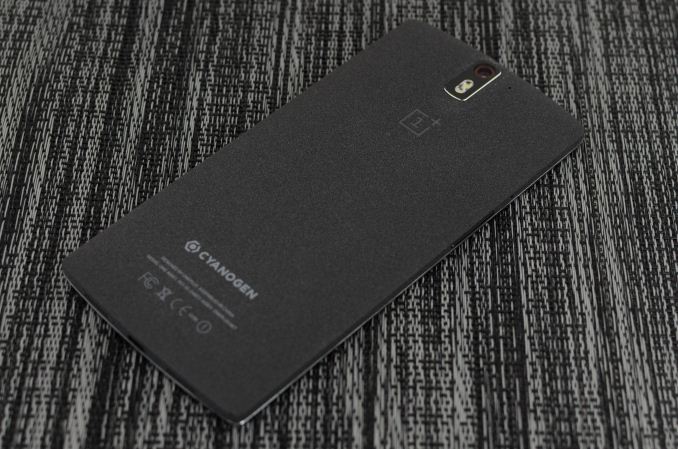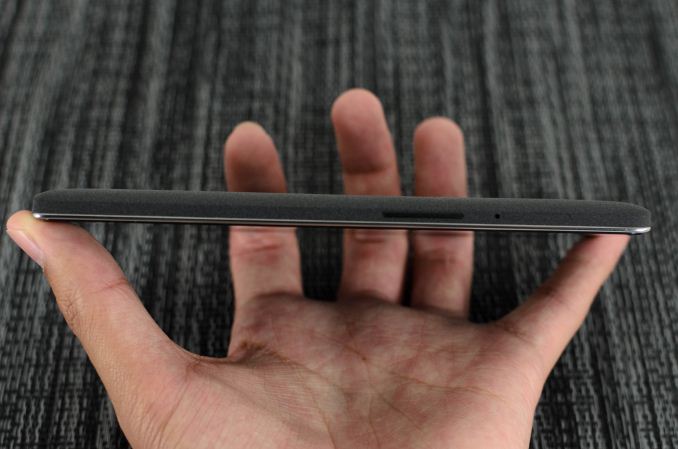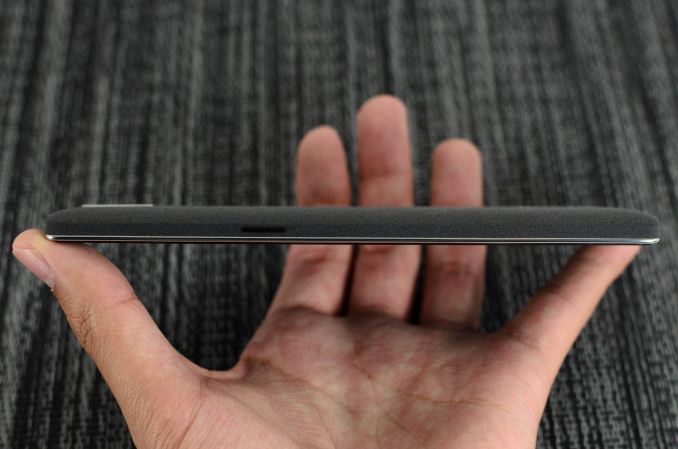The OnePlus One Review
by Joshua Ho on November 19, 2014 8:00 AM EST- Posted in
- Smartphones
- Android
- Mobile
- OnePlus

The OnePlus One has been one of the most hyped smartphones of 2014. There's really not much else to be said, as OnePlus' marketing has been quite noticeable amongst Android enthusiasts. The OnePlus One seems to come from nowhere, although there is a noticeable resemblance to the Oppo Find 7A which is produced in the same factory. The OnePlus One is said to be a flagship killer, as its high-end specs come with a mid-range price. The 16GB version starts at 299 USD and the 64GB version starts at 349 USD. With a 5.5" 1080p display, Snapdragon 801 SoC, and plenty of other bits and pieces to go around, the specs are certainly enough to make it into a flagship phone. Of course, the real question is whether it really is. After all, while specs provide the foundation, what makes a phone bad, good, or great has to do with the entire phone, not just the spec sheet. At any rate, I've attached this spec sheet below to give an idea of what to expect from the phone.
| Oppo Find 7a | OnePlus One | |
| SoC | MSM8974ABv3 2.3 GHz Snapdragon 801 |
MSM8974ACv3 2.45 GHz Snapdragon 801 |
| RAM/NAND | 2 GB LPDDR3, 16GB NAND + microSD | 3GB LPDDR3, 16/64GB NAND |
| Display | 5.5” 1080p IPS LCD (JDI) | 5.5” 1080p IPS LCD (JDI) |
| Network | 2G / 3G / 4G LTE (Qualcomm MDM9x25 UE Category 4 LTE) | 2G / 3G / 4G LTE (Qualcomm MDM9x25 UE Category 4 LTE) |
| Dimensions | 152.6 x 75 x 9.2 mm, 170 grams | 152.9 x 75.9 x 8.9 mm, 162 grams |
| Camera | 13MP (4128 x 3096) Rear Facing, 1/3.06" CMOS size (Sony IMX214), F/2.0, 5MP FFC w/ F/2.0 aperture | 13MP (4128 x 3096) Rear Facing, 1/3.06" CMOS size (Sony IMX214), F/2.0, 5MP FFC w/ F/2.0 aperture |
| Battery | 2800 mAh (10.64 Whr) | 3100 mAh (11.78 Whr) |
| OS | Android 4.3 with ColorOS | Android 4.4.4 with CyanogenMod 11S |
| Connectivity | 802.11a/b/g/n/ac + BT 4.0, USB2.0, GPS/GNSS, DLNA, NFC | 802.11a/b/g/n/ac + BT 4.0, USB2.0, GPS/GNSS, DLNA, NFC |
| SIM Size | MicroSIM | MicroSIM |
Needless to say, the OnePlus One is a close cousin of the Find 7a, and its specs are top notch. There's a great foundation, so we'll move on with some initial hardware impressions.
Of course, the first part to look at is industrial and material design, along with any other immediate observations about the phone. From the front, the phone is almost a pure expanse of black glass. There are outlines for the capacitive keys, but these are quite faint most of the time. The contrast of the silver plastic ring only emphasizes this, and the lack of logos helps to make the design stand out by virtue of its minimalism. Picking it up, the feel of the sandstone black finish is incredibly unique and unlike anything I've ever felt. The finish has been described as soft sandpaper, and that's a description I'd agree with. It makes the phone feel much grippier than one might expect. The back cover is also strong, with no real give and no flex. Other than a few logos, the only significant design elements on the back are the camera, dual LED flash, and a hole for the microphone. The front of the phone has surprisingly great attention to detail as well. The silver plastic piece on the front of the phone makes the finger smoothly roll off of the display when swiping around, and the imperceptible feel of the earpiece helps to contribute to the sense that this is a single, well-built phone.
On the sides, the minimalistic theme continues. There's only a power button on the right side, a headphone jack and microphone port on the top, and a volume rocker on the left side. The SIM tray is also on the left side, and on the bottom of the phone we see two speakers, a USB port, and a microphone hole. In general, the feel of the power and volume buttons are great, with no slack and a clean, if subdued click upon activation.
Needless to say, OnePlus has done a fantastic job. However, there are a few issues to talk about. First, the size is definitely too much to handle. If the LG G3 was at the very edge between a phone and phablet, the OnePlus One firmly steps into phablet territory. At some point a line in the sand has to be drawn, and it only makes sense to do so here. The angular corners of the OnePlus One combined with its larger footprint makes for a phone that is almost impossible to comfortably use with one hand. I can't help but feel that this would've been a far more impressive phone if shrunk to a 5" display size, as in my experience it takes two hands to comfortably use this phone. The other issue is much more subtle though. For some reason or another, the glass lens covering the display of the phone feels as if it has noticeably higher friction than other phones I've used. It almost feels as if the oleophobic treatment of the glass is either missing or thinner than most. Of course, overall the phone is great from a basic design perspective. The size seems to be a matter of OnePlus' start-up position and the need to share parts with the Find 7a, although the feel of the glass is unlikely to be an issue for most.













148 Comments
View All Comments
melgross - Wednesday, November 19, 2014 - link
I know this may seem to be a very minor issue and nitpicking, but I would just like to comment that the thinness of the oleophobic coating, if there is one, would have no effect on the feel of the screen. You interact with the surface of the coating, not the thickness. It might lead to a shorter effective life for the coating, but not a difference in swiping feel.I bothers me, because this is something that a little bit of thought would have revealed as being illogical. And if writers write things that are illogical in one part of the article, where else will they do that where we won't notice it, and come to a wrong conclusion because of it?
cr0wb4r - Wednesday, November 19, 2014 - link
I think two options in CM11S will make all the nit picks worthwhile: Profiles and double tap to wake.Having a Home and Work profile allows me to turn off/on lock screen. Huge
Double tap to wake and see notifications and then double tap status bar area to go back to sleep. Again Huge.
Just my 2 cents on the plethora of CM11S options
cr0wb4r - Wednesday, November 19, 2014 - link
Sorry, forgot to mention that Profiles make it AUTOMATIC to turn on/off lock screen. I realize this is obvious to most...phoenix_rizzen - Thursday, November 20, 2014 - link
Profiles have been available in Android ROMs for at least a year now, if not longer. It's one of the first things I turn off when flashing an AOSP-based ROM on my phone.DT2W has been available in Android ROMs within a month or so of LG releasing their sources, as they were the first ones to enable it (works wonderfully with the LG G2 where the power button is on the back).
IOW, neither of these features are exclusive to CM 11S, or even CM, or even just AOSP.
toyotabedzrock - Wednesday, November 19, 2014 - link
I have read that the updated version of Chrome running on lollipop on the nexus 5 sees a rather large bump in the Octane benchmark.Allan_Hundeboll - Wednesday, November 19, 2014 - link
I was beginning to think this site would never review the OPO, much appreciated.But:
Oneplus One has strong reception! (But lacks LTE 800Mhz band)
And people should know that a 5.5" phablet is big, so how can the size be a problem?
Maybe the author also think the iphone 6+ is just too big? Let customers decide what screen size he/she wants, please.
Joshua Ho seem to forget this phone wasn't made for average joes! CM is all about customization so how can too many options be a problem? Please understand a lot of geeks chose android because we appreciate the almost endless possibilities and CM takes this further than google's stock android.
So this phablet is perfect for XDA members NOT for someone like my mother.
mfmx - Thursday, November 20, 2014 - link
Are you sure your mother wouldn't like it? My grandmother that is 96 years old thinks 5,5" is the perfect size for her. Also my mother that has a 5,3" phone doesn't want a smaller device.Munna2002 - Friday, November 21, 2014 - link
My mother and grand aunt also like the size of the OPO.grayson_carr - Thursday, November 20, 2014 - link
The display calibration results are perplexing to me. I know when the phone was first released, it was using a calibration profile created by then CyanogenMod employee François Simond (supercurio), who has also worked with Anandtech on reviews in the past. It didn't surprise me that the screen was very accurate then. But then a couple months ago, OnePlus released an update that did away with supercurio's calibration profile (and let supercurio go / didn't renew his contract) because too many people were complaining that the screen looked too yellow (warm), as 6500K often does to the untrained eye. The update shifted the white point drastically up to the 8000K range (super cold and blue looking) and presumably made colors less accurate. I sold the device a short time later due to annoying bugs, but now I'm confused by these results. What version of CM11S was this phone running as tested? Did you test an old version of the software or did they reinstate the proper calibration profile in a recent update? This review could mislead some people hoping for a properly calibrated screen if you did indeed test the One with the older software.techcrazy - Thursday, November 20, 2014 - link
Where is Sony Xperia Z3 and Z3 Compact review?